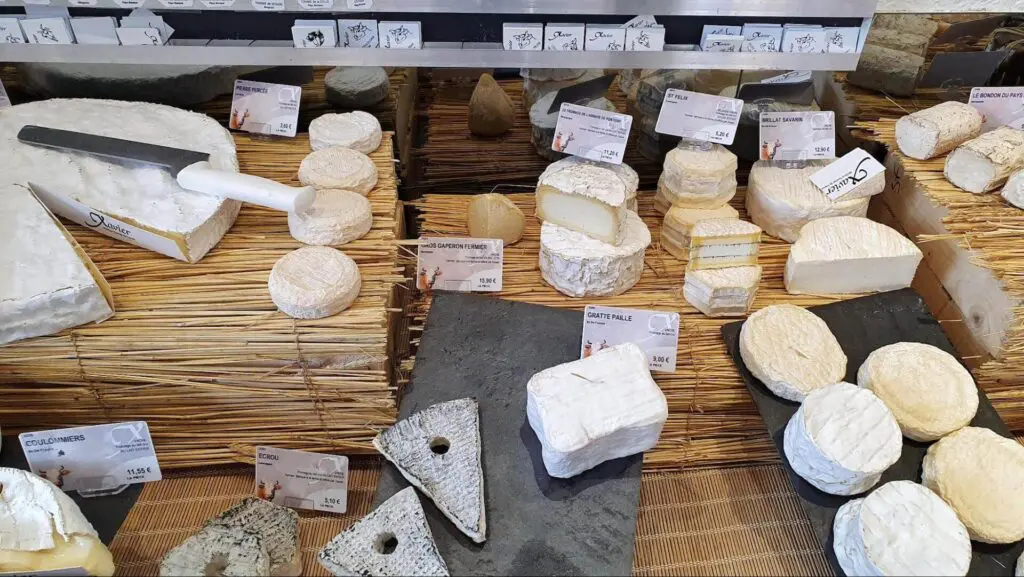Must-have Ingredients When Cooking French Food
French cuisine has a longstanding reputation for its rich and sophisticated flavors. Every bite tells a story of tradition, culture, and meticulous craftsmanship. In fact, the French gastronomic meal has been awarded UNESCO World Heritage status as part of the “Intangible Cultural Heritage of Humanity” (the baguette, too)!
Here at Taste of Toulouse, our guides don’t just love to go to restaurants; we’re all about scouring the markets for bread, cheese, charcuterie, and seasonal ingredients to make classic French meals in our own kitchens.
Yet, surprisingly, few ingredients are often at the heart of this culinary art. Often, classic dishes are built upon simple foundations of a few choice ingredients – of excellent quality – that complement each other perfectly.
The following list is a brief look at some of the key ingredients that go into the French dishes we make at home. We hope you are inspired to continue your journey into French cuisine.
If you will be traveling in France and would like to take a food tour with our local culinary experts, please browse our selection of Walking Food Tours in Toulouse.

Herbs and Spices in French Cooking
When we think of French cooking, the subtle infusion of herbs and spices plays a pivotal role in imparting unique flavors and aromas:
Herbes de Provence: This aromatic blend, featuring thyme, rosemary, oregano, and lavender, is reminiscent of the sunny landscapes of Provence. Think of it gracing a slow-roasted chicken, blending with olive oil, or coating the outside of delicious French sausage.
Tarragon: With its slightly licorice flavor, tarragon is the star in the classic béarnaise sauce, often drizzled over a tender steak or fresh asparagus.
Bay Leaves: These glossy leaves are a cornerstone for slow-cooked dishes. Add them to a simmering pot of boeuf bourguignon or a hearty cassoulet, and they’ll release a depth of flavor that ties the dish together.
Bouquet Garni: A classic bundle of herbs, normally tied with string, consisting of herbs like bay leaf, thyme, and parsley. While there’s no standard combination of herbs for the bouquet garni, the bundle is normally prepared for use in preparing soup, stock, casseroles, and stews.
Salt & Pepper: For French cooking, use high-quality sea salt for seasoning during cooking, and sprinkle fleur de sel, a hand-harvested sea salt, as a delicate finishing touch to enhance flavors.
Do yourself a huge favor and stop buying pre-ground black pepper in favor of a pepper mill and whole peppercorns. Once you start using freshly ground pepper, you’ll never go back!
Piment d’Espelette: A cornerstone of Basque cuisine, Piment d’Espelette is a mildly spicy pepper with a subtle sweetness, prized for its AOC (Appellation d’Origine Contrôlée) status, guaranteeing its authenticity and quality.

Dairy Products
Dairy is an absolute cornerstone of French cuisine, from creamy, indulgent desserts to the world-class cheeses for which the country is so famous.
Butter: Beyond just a spread, butter is the soul of French cuisine. Its richness is unparalleled, whether it’s creating the flaky layers of a croissant, the base of a sumptuous sole meunière, or simply melted over freshly steamed vegetables.
When baking, most recipes call for unsalted butter (called “doux” in French). However, few things are more simple or satisfying than good quality salted (“demi-sel”) butter spread over freshly baked French bread.
But attention! You likely won’t see butter with your bread at meal times unless it’s breakfast. The French believe in the verb “saucer,” which means to mop up your sauce with your bread.
Cream: What’s a potage parmentier without a dollop of cream? Or a tarte tatin without that creamy caramel undertone? Cream lends a velvety texture and luxuriousness to both savory dishes and desserts.
Cheese: France boasts over 400 varieties of cheese. Melted Camembert forms the heart of a Camembert roti, while Roquefort’s tangy bite contrasts beautifully with sweet pears in a classic salad, and Reblochon is the key ingredient in the hearty tartiflette.
From creamy to crumbly, there’s a cheese to elevate every dish.
Learn more with our handy Beginner’s Guide to French Cheese. And if you are in Toulouse, you may want to book a place on our Cheese and Wine Tasting Experience, led by a former cheesemonger.

Meat and Fish in French Cuisine
Fish and meat feature heavily in French cooking, which is understandable given the country’s long tradition of farming and access to the sea.
(However, vegetarians and vegans need not be put off; most French cities are now home to an array of exciting veggie options. If you’re looking for places to eat in Toulouse, our What are the best places to eat in Toulouse? features several restaurants offering first-class vegetarian dishes.)
Duck: Synonymous with the southwest regions, duck graces plates in dishes like confit de canard and the decadent foie gras. It’s known for its rich meat, often paired with fruity accompaniments like orange in the classic canard à l’orange.
Find inspiration for tasting high-quality duck dishes with our Must-Try Dishes While in Toulouse and Where are the Best Places to Eat in Toulouse?
Rabbit: A traditional choice, rabbit is stewed in dishes like lapin à la moutarde, where its delicate meat harmonizes with robust mustards and fresh herbs.
Pork: A staple in French cuisine, pork is celebrated in dishes such as coq au vin, where it’s slow-cooked to perfection, and in the charcuterie arts, showcasing sausages and pâtés.
Its versatile flavor profile pairs well with everything from earthy lentils in petit salé aux lentilles to the sweet and tangy elements in traditional Normandy apple-based dishes.
Seafood: Coastal France celebrates seafood in its glory. Mussels steamed in white wine and garlic (moules marinières) or smothered in a creamy Roquefort sauce, scallops seared to perfection (coquilles Saint-Jacques), oysters from both the Atlantic and the Mediterranean, and fish simmered in rich sauces showcase the country’s maritime bounty.

Fruit and Vegetables in French Cuisine
The allure of French cuisine lies not just in its meats and dairy but in the careful use of vegetables and fruits, which provide both contrast and complement to its richer counterparts.
Leeks: A cornerstone in French kitchens, leeks lend their delicate onion-like flavor to dishes like potage leek et pomme de terre (leek and potato soup). Their subtle taste works wonders when layered in a “quiche aux poireaux” (leek quiche), allowing other ingredients to shine without overshadowing them.
Shallots: Less pungent than onions, shallots bring a gourmet touch to many recipes. Consider “échalotes confites” (caramelized shallots) accompanying a juicy steak or finely chopped in the delicate sauce béarnaise. And of course, what French vinaigrette is complete without shallots?
Figs and Plums: Fruits in French dishes offer a sweet reprieve from savory heavyweights. Figs, often roasted and paired with foie gras, create a beautiful juxtaposition of textures and flavors.
Plums, on the other hand, take center stage in the rustic tarte aux quetsches (plum tart), their tartness balancing the sweet pastry.
If you’re looking for fresh fruit and vegetables in Toulouse, read our 5 best food markets in Toulouse for inspiration.

Liquors and Wines
Wine and spirits in French cooking are not mere afterthoughts—they’re integral elements that enhance, tenderize, and deepen the flavors of myriad dishes.
Wine: The magic of a coq au vin or boeuf bourguignon is, in large part, attributed to the deep flavors of the wine reduction. Whether it’s the reds of Bordeaux or the whites of Burgundy, wine elevates stews and sauces to sublime levels.
Armagnac: A spirit from the Gascony region, Armagnac, with its deep and complex flavor profile, is a Toulouse favorite. This distinctive brandy, often aged for years, imparts a rich, woody essence to dishes like the luxurious foie gras with Armagnac.
It also stars in desserts, notably with prunes soaked in Armagnac, a classic pairing that melds the spirit’s robust character with the fruit’s natural sweetness.
Brandy: Brandy, especially Cognac, brings depth to desserts and meat dishes alike. Imagine a juicy “poulet au Cogna” or the spectacle of a crêpe Suzette being flambéed.
Pastis: This anise-flavored spirit, while primarily a drink, occasionally finds its way into Provençal dishes, lending a hint of licorice to seafood stews or marinades.
Although not used in cooking as much, France has a fabulous artisanal beer scene, and most French cities are now home to trendy craft beer establishments alongside more traditional pubs. Read our Guide to French Beer to Learn More.

Staple Ingredients
French cuisine’s magnificence often emerges from humble beginnings. Basic, everyday ingredients form the foundation on which culinary masterpieces are built.
Flour: From the crusty exterior of a baguette to the base for a roux in béchamel sauce, flour is indispensable. Its versatility shines especially in pâte à choux, the puff for éclairs and gougères.
Eggs: Whether it’s the delicate setting of a crème brûlée, the rich filling of a quiche Lorraine, or even the simplicity of an omelette, eggs play a versatile role in French cooking.
Stocks: The essence of many French dishes lies in their stocks. A good bouillabaisse owes its depth to fish stock, while a velvety soupe à l’oignon (onion soup) begins with a rich beef stock. Being able to prepare a first-class stock is essential to preparing many delectable French classics.

Baking Essentials
Baking is an art in French culinary tradition, demanding precision, patience, and the finest of ingredients.
Chocolate: Beyond just desserts, chocolate in French cuisine is a realm in itself. The classic mousse au chocolat owes its decadence to high-quality dark chocolate, while the tarte au chocolat showcases its silky smoothness.
Puff pastry: This buttery, flaky wonder transforms into iconic pastries such as “croissant”, “pain au chocolate”, and “pithiviers”. Its layers encapsulate the essence of French patisserie: meticulous, indulgent, and downright delicious. When buying store-bought puff pastry dough, make sure it’s made with butter!
Pâte Brisée: Known for its flaky and buttery texture, pâte brisée is a versatile pastry dough used in classic French tartes and quiches, offering a perfect balance between tenderness and structural integrity.
Pâte Sablée: Akin to shortbread, pâte sablée is the foundation of many French desserts, ideal for sweet tart shells that cradle everything from fresh fruit to rich, creamy fillings.
Explore French Cooking With Taste of Toulouse
In the vast panorama of global cuisines, French food stands as a testament to what can be achieved when classic ingredients are harmoniously matched.
From the rustic kitchens of Provence to the fine-dining establishments of Paris – and to our own humble apartments in Toulouse – it’s evident that the magic of French cuisine is rooted in its reverence for produce.
As we’ve journeyed through some essentials, it’s clear that each one, be it a simple shallot or a rich slab of foie gras, plays a pivotal role in crafting dishes that are acclaimed globally but also savored locally.
For those who seek to immerse themselves in this culinary world, do as we do: Start with the finest ingredients and let the fullness of their flavors play a lead role in your cooking.
If you’re traveling in Toulouse, the Victor Hugo Market is a must-visit site for any foodie. Join us on our Food Tour of the Victor Hugo Market to learn the story of this historic market and to sample some delicious artisanal treasures along the way.
If you have any questions, please contact us.




